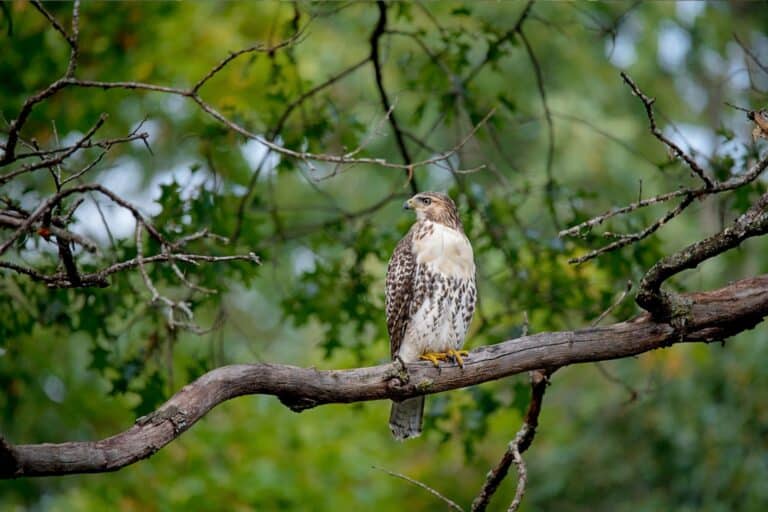
Hawks are among the most graceful and plentiful birds of prey, found all over the world in every climate and biome. They also happen to be one of the most persistent predators of other birds, particularly poultry, making them a long-time nemesis of farmers and homesteaders.
The sudden arrival of a hawk is usually accompanied by a great commotion of wing beats and feathers, and they are usually gone just as quickly, often leaving behind a little blood and not much else.
They are definitely good at their jobs, and this begs the question: are hawks dangerous?
No, hawks are generally not dangerous to human beings, although they can inflict injuries with their talons and beaks if cornered or handled, or if their nests are threatened.
You personally it won’t have much to fear from Hawks when it comes to physical danger, but small pets, livestock and poultry definitely do. Keep reading to learn more about hawk behavior.
Understanding Hawk Behavior
Hawks make up entire categories among birds of prey, and the precise definition of a hawk can vary depending on where you are in the world and who you ask.
In North America, the word hawk is generally used to describe any of the small to medium-sized birds in the Accipitridae family.
This family contains eagles, Old World vultures, kites and harriers, as well as the New World hawks.
Hunting behavior varies, but is typically characterized by the hunting of other birds by a fast, horizontal dash taken from concealment, or else the taking of other animals, usually small mammals, from above.
In terms of human danger, it is worth noting that most hawks are not big enough to pose a serious threat to an adult human, despite their relatively large talons and sharp beaks.
That being said, they can certainly cause significant injuries adults, and serious ones to small children or animals if they are provoked to attack or trying to take prey.
Except in the case of the smallest pets and livestock, this is rarely a concern since hawks will almost never attack animals that are much larger than their usual prey.
In fact, there are many accounts of farmers and homesteaders who have been able to scare off attacking hawks simply by approaching them and making loud noises, or else convincing hawks to look elsewhere when they are too near their preferred prey.
If a hawk has doubts about the success of an attack, it will invariably hold off or look somewhere else for an easy meal rather than risk injury, unless it is starving or very desperate.
Are Hawks Aggressive Toward Humans?
Almost never, unless the animal is handled, cornered or has its nest and young directly threatened.
Even in these cases, the hawks will usually give several warnings before attacking, including loud calls and sometimes “dive-bombing” or swooping at the offender before committing to violence.
Of course, there are always exceptions to every rule, and there have been a few documented cases of people being attacked by hawks with seemingly no rhyme or reason.
Why this occurs remains a subject of speculation.
Have Hawks Ever Attacked Humans?
Yes. Hawk attacks on people have occurred and probably will continue to well into the foreseeable future.
There is no concrete evidence to suggest that these attacks are on the rise, but they do tend to make local headlines when they do happen.
In most cases, the victims of hawk attacks are small children or animals, although there have been a few instances of adults being injured as well.
As is the case with most animals, a healthy, well-fed hawk is unlikely to see humans as prey, and will generally steer clear unless defending its nest.
How Do Hawks Attack?
Hawks attack directly by swooping down on their prey from a perch or in some species attacking from above while in flight.
In both cases, the hawk will use its powerful talons and sharp beaks to inflict injury.
The gripping strength of a hawk can be pretty impressive, and puncture wounds from its talons are likely.
Keep in mind that the beak of a hawk is designed to incise and strip flesh, and can easily to the same to yours!
Note that many hawk species, like most birds, and more likely to “harry” intruders and potential threats by first trying to scare them off with repeated dives, or by flogging with their wings.
Only if these warnings are ignored will the hawk then resort to direct attack.
What Causes Hawk Aggression?
Against humans, hawk aggression is usually a result of straying too close to a nest, cornering it, or attempting to help a hawk that is trapped or injured.
These are all examples of perceived threats to the hawk or its young. In some cases, people have been attacked for seemingly no reason though these “blue sky” attacks are rare.
As for attacks on other animals, particularly small pets and poultry, these are usually due to the hawk selecting the animal for its prey.
This happens all the time in the case of chickens, ducks and their young but also the smallest dogs and cats.
Do Hawks Eat People?
No, or at least they won’t attack you as a source of food. A hawk takes live prey in almost every instance, but they may eat flesh from a fresh corpse.
If something were to happen to you in a hawk’s territory it is not impossible that a hawk might nibble on your body!
Are Hawks Territorial?
Generally not, so long as they are ranging around or on the wing. A hawk is unlikely to attack or hassle you just because you are in the same area it is in.
However, the closer and closer you get to the hawk’s nest the more closely it is going to watch you, especially if it has eggs or young in it. When you draw too close to the hawk’s nest, watch out!
Some hawks can also become standoffish when they have prey cornered or otherwise close to being dispatched.
In these cases, it is not unheard of for a hawk to stand its ground even when approached by a human or larger animal.
How Strong is a Hawk?
Strong for their size, but only the largest pose a serious risk to humans. Most adults can easily overpower a hawk when coming to grips with it.
This does not mean they should be underestimated, as even the smaller species can still cause injury.
What Should You Do if You See a Hawk?
If you see a hawk, and don’t have any pets or other animals to worry over, just admire it. However, if you have smaller animals, particularly chickens or ducks, be ready to act right away.
If hawks have their eye on your animal they will go for it! The best thing you can do to protect your animals is to keep them under cover in coops or runs with roofs or netting over it.
If a hawk does attack, try to scare it off by making loud noises or charging at it.
Remember, these birds of prey are highly intelligent, and will wait for the very best opening before striking with lightning speed. When that happens it might be too late to intervene.
Consider running off a lurking hawk if you spot it on a nearby perch if you want to keep your animals safe.
What Should You Do if Attacked by a Hawk?
You are unlikely to be attacked by a hawk, but if you are immediately protect your face, ears and neck, as these places are the most vulnerable to a hawk’s talons and beak.
Try to cover up as much as possible with clothing, a backpack or whatever you have on hand.
If you can safely get away, do so; as running is usually the best defense, and they tend to give up once you have gained enough distance.
It is likely attacking since you strayed too close to its nest in the first place.
If, for whatever reason, retreat is impossible you can try to beat back the hawk using anything at hand.
Though capable predators, hawks are still birds and that means they are pretty delicate. You might try to restrain the hawk in order to avoid hurting it, but make sure it cannot bite you!
Also, one last word of caution: don’t even think of killing a hawk unless you have no other choice.
Pretty much all of these birds are protected species at the state and federal level, and you could be fined or even jailed for taking one out.
Do Hawks Carry Diseases People Can Catch?
No, aside from the usual avian mites and fleas, along with any germs they have come into contact with from eating raw meat.
Tom Marlowe practically grew up with a gun in his hand, and has held all kinds of jobs in the gun industry: range safety, sales, instruction and consulting, Tom has the experience to help civilian shooters figure out what will work best for them.


